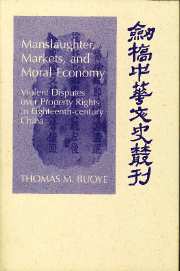 Manslaughter, Markets, and Moral Economy
Manslaughter, Markets, and Moral Economy Published online by Cambridge University Press: 28 October 2009
Routine memorials were used in the Ming and Qing dynasties to communicate public matters to the Grand Secretariat, which forwarded the memorials with recommendations for action to the emperor for his consideration. The Ministry of Justice used routine memorials to report on a variety of matters, including homicides. The staff of the Number One Historical Archives has categorized these memorials by subject: autumn and spring assizes, homicides, robbery, official corruption, prisons, arrests and seizures, and others. Within the category of homicides, there are four subcategories: blows and affrays, land and debt, marriage and illicit sex, and other. This study utilizes only homicide cases that were related to land and debt (tudi zhaiwu) disputes.
Routine memorials reporting homicide originated at the county (xian) level and flowed upward through the bureaucracy. The entire process from the arrest until the case reached Beijing could take up to six months, though some cases moved through the system more quickly. Each case was reviewed at the prefectural and provincial level. Thus, a complete document was very repetitive, containing reports from each administrative level, county, prefecture, province, and the Three Judicial Offices in Beijing. The county-level (xian) report was the most extensive, and usually included a formal complaint, depositions of the accused and eyewitnesses, a coroner's report, and the county magistrate's summary of the case and suggested punishments. Prefectural-level reports ordinarily repeated the summaries of the county-level report without additional comment. Provincial officials and the Three Judicial Offices, however, reviewed cases critically, evaluated the performance of the county magistrates, and addressed questions of sentencing.
To save this book to your Kindle, first ensure [email protected] is added to your Approved Personal Document E-mail List under your Personal Document Settings on the Manage Your Content and Devices page of your Amazon account. Then enter the ‘name’ part of your Kindle email address below. Find out more about saving to your Kindle.
Note you can select to save to either the @free.kindle.com or @kindle.com variations. ‘@free.kindle.com’ emails are free but can only be saved to your device when it is connected to wi-fi. ‘@kindle.com’ emails can be delivered even when you are not connected to wi-fi, but note that service fees apply.
Find out more about the Kindle Personal Document Service.
To save content items to your account, please confirm that you agree to abide by our usage policies. If this is the first time you use this feature, you will be asked to authorise Cambridge Core to connect with your account. Find out more about saving content to Dropbox.
To save content items to your account, please confirm that you agree to abide by our usage policies. If this is the first time you use this feature, you will be asked to authorise Cambridge Core to connect with your account. Find out more about saving content to Google Drive.